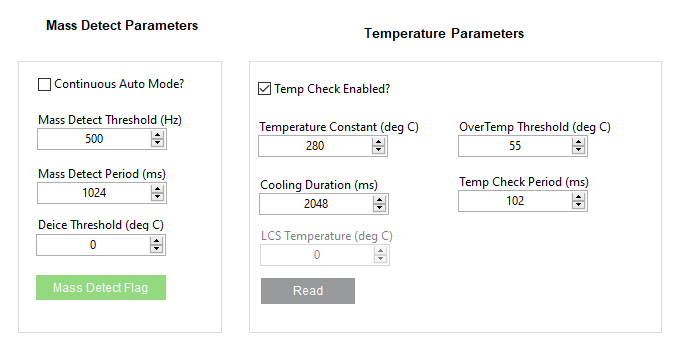SLAU915 May 2024 ULC1001
- 1
- Description
- Get Started
- Features
- 5
- 1Evaluation Module Overview
- 2Hardware
-
3Software
- 3.1 GUI Setup
- 3.2 System Overview
- 3.3
GUI Overview
- 3.3.1 GUI Top Level Layout
- 3.3.2 High Level Page
- 3.3.3 Register Map Page
- 3.3.4 I2C Configuration Page
- 3.3.5 GUI Functions
- 4Hardware Design Files
- 5Additional Information
3.3.2.3 Cleaning Mode Settings
Texas Instruments created four main cleaning modes for removing ice, mud, and water from the lens of the LCS. The GUI allows select settings to be adjusted for these cleaning modes and also gives the user freedom to create two custom cleaning modes.
As mentioned in Section 3.2, there are nine modes that can contain up to 30 configurable bursts. Each burst is played in the order the burst is programmed and the #Bursts setting must be set correctly to play the number of desired bursts. The #Burst register is USER_Params_numBurstsPerMode_x, where x equals 0 through 9. The mode sequences are enumerated with registers using the following syntax, USER_Params_modeSequence_n_m, where n equals the mode number (0-9) and m equals the burst sequence order (0-29). There are up to 30 bursts maximum per mode. The following sections show Texas Instruments' predefined bursts.
Any cleaning mode, excluding Auto mode, can be run continuously by checking the Continuous Mode check box located in the top right corner above the burst 29 column name. When a mode is running continuously, un-check the Continuous Mode checkbox to put the ULC1001 back into Single Mode; the mode runs one additional time and then stops.
The additional parameters on the Cleaning Modes page are shown in Figure 4-17 and described in Table 4-12 and Table 4-13.

Figure 3-17 Cleaning Mode Settings
| Parameter | Description |
|---|---|
| Continuous Auto Mode? Check Box | Enables the Auto mode to run automatically without setting the USER_Commands_flag_newCommand at the specified period when the device is in the active power mode. PWR_CTL = 0x00. |
| Mass Detect Threshold | Frequency impedance threshold that controls how sensitive the system is to contaminants on the LCS. |
| Mass Detect Period | Time interval used when Continuous Auto mode is enabled. |
Deice Threshold | Temperature threshold to activate deice in Auto mode sequence. |
| Parameter | Description |
|---|---|
| Continuous Temp? Check Box | This check box controls how the temperature algorithm is run. When checked, the temperature burst runs based on the Temp Check Period and interrupts any passive burst to check the LCS temperature, then returns to the burst being played. When enabled, the temperature burst is also run at the beginning of any mode |
| Temperature Constant [°C] | LCS temperature estimation algorithm constant auto updated by Calibration Mode. |
| OverTemp Threshold [°C] | LCS Temperature threshold at which the ULC1001 flags an Over Temperature condition. |
| Cooling Duration [sec] | Cooling time provided by ULC1001 to LCS in the event of an Over Temperature condition. |
| Temp Check Period [sec] | Time period between temperature checks in continuous mode. |